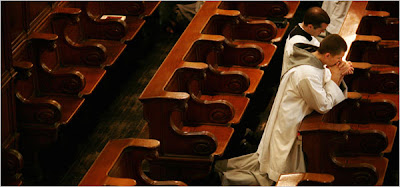 One of the stops Pope Benedict will be making this week is at the seminary for the Archdiocese of New York. And the New York Times has a compelling look at how vocations are doing there (hint: not great) and the ongoing effort to recruit more young men:
One of the stops Pope Benedict will be making this week is at the seminary for the Archdiocese of New York. And the New York Times has a compelling look at how vocations are doing there (hint: not great) and the ongoing effort to recruit more young men:
The banners hanging in the main corridor of St. Joseph’s Seminary in Yonkers declare, “Through Faith We Grow.” The class portraits that line that very same corridor tell the opposite tale. Half a century after the halcyon days when several hundred men at a time studied to be ordained as priests for the Roman Catholic Archdiocese of New York, only 22 are enrolled.
Even more alarming to Catholics, although six men expect to be ordained in May, none are entering the first-year theology program. While seminary officials attribute the sudden drop to extra preparatory course requirements that went into effect this year, it is nonetheless a jarring development.
“You do what you can, as well as you can, for as long as you can, and hope it works,” said Bishop Gerald Walsh, the seminary’s rector. “I’d be optimistic if we had enough clergy present for young people and willing to talk to them.”
He will have enough — and then some — on Saturday, when Pope Benedict XVI visits the seminary for a prayer service and youth rally. The pope’s mere presence will be a jolt of encouragement to the seminarians. It will also offer them and other priests and nuns the chance to mingle with 20,000 young people and plant a seed for vocations.
There will be flashy videos, with quick cuts, stirring sound tracks and fearless priests on New York streets. Goody bags will include glossy post cards of the pontiff emblazoned with the word “Willkommen!” — and the Web address nypriest.com, the seminary’s recruiting site. In coming weeks, the archdiocese will send its schools posters that announce, “The World Needs Heroes,” including one of black-suited priests crossing an intersection — looking like “Going My Way” meets “Reservoir Dogs.”
Officials of the archdiocese do not apologize for embracing Madison Avenue marketing to counter a sharp decline in vocations.
An increasingly secular and materialistic culture, reluctance among the young to accept lifelong celibacy, and anger over the church’s handling of sexual abuse scandals have all contributed to the precipitous drop, the officials say.
Vocational directors recognize that the public’s confidence has been shaken by the scandals. They have chosen, however, to focus their marketing campaign on an upbeat message.
The Rev. Luke Sweeney, director of vocations for the archdiocese — which covers the Bronx, Manhattan, Staten Island and seven counties west and north of the city — says the church must make its case if it hopes to reinvigorate a priesthood that is increasingly elderly. “How do we get the ‘cool’ factor back into the priesthood?” Father Sweeney said. “If we don’t sell the priesthood, we can’t legitimately ask a young man to consider the priesthood as a vocation.”
What the seminary lacks in numbers, it may make up for in intensity and eagerness. The seminarians speak of finding a joy and purpose that eluded them in secular careers.
“We live in a very confusing world, a world where there is a lot of evil in it, and good men need to step forward,” said Brian Graebe, a former high school teacher who is finishing his first year. “You can stick your head in the sand, or you can do something to change it. What more heroic life is there than to touch these eternal mysteries?”
St. Joseph’s Seminary — informally known as Dunwoodie, after its neighborhood — is hardly alone in its diminished fortunes. Nationally, the enrollment of seminarians in four-year theology programs has been flat for the last decade, currently numbering 3,286, said Sister Katarina Schuth, a professor at St. Paul Seminary School of Divinity, part of the University of St. Thomas in Minnesota. More than a quarter of those seminarians, she said, were foreign born.
“It’s a tough time for the church,” Sister Schuth said. “Dunwoodie has lost proportionately more than most. It really is a puzzle, given the huge population of New York and the boroughs.”
When St. Joseph’s opened in the late 1800s, its stone castle, topped by a gleaming cupola and perched majestically atop a hill, was described by Bishop Bernard McQuaid of Rochester as “the grandest seminary building in Christendom.” It was also, according to the Rev. Thomas J. Shelley, a Fordham University professor, one of the most progressive seminaries of its age, with an intellectual tradition to rival the best Catholic universities, until a Vatican crackdown on modernist thought a century ago led to a more orthodox approach.
Still, priests who were seminarians during the 1940s and ’50s recall a tranquil place whose daily rhythms were marked by the clanging of the bell for classes, meals and Mass. Many came from immigrant, working-class homes where the religious life was seen as a step up.
The Rev. Gerard J. DiSenso, who grew up poor in the Bronx, said the first time he had a room all to himself was when he entered the seminary in 1947.
That he was surrounded daily by more than 200 seminarians was encouraging and humbling.
“You sensed that you were not absolutely needed,” said Father DiSenso, who is now retired. “There were enough candidates that the seminary could afford to discharge people.”
He still goes to the seminary weekly to use its library, though he has little contact with the few men who are now there. “It’s like a shell of itself,” he lamented. “It’s completely different.”
Read on for more.
Photo: by Todd Hesler, The New York Times

